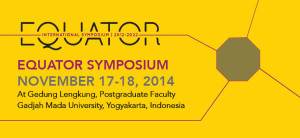Equator Symposium
The One and the Many: Practices in Ethics and Aesthetics in 21st Century Democracy.
November 17-18, 2014
At Post-graduate Faculty of Gajah Mada University, Yogayakarta, Indonesia
The Equator Symposium attempts to reveal the ecosystems within groups of many people (artists groups, hobby-based communities, business groups, etc.) in the organisation of their places (whether in the city, village, neighbourhood, state or between all of these). Examining encounters, both physical and virtual, and how these encounters are then disseminated to more people, is the first step in our efforts to reveal the ecosystems of these groups.
ES 2014 tries to reveal the ecosystem of the association of the many (artist groups, societal hobby-based groups, authority associations, etc) in the order place of their lives (city, village, country, as well as between all of these). The encounters, either physical or virtual, and how those encounters are then disseminated to many more people is our first step in the effort to uncover the ecosystem of these groups.
Registration
Deadline for submission: October 31, 2014.
Download ES 2014 Registration form here.
Deadline for Fellowship submission: October 24, 2014 (For Indonesian citizen only).
Download ES 2014 Fellowship form here.
The One and the Many is in fact the title of Grand Kester’s book about the diversity forms of cooperation in the field of contemporary fine art. Kester’s considerations are not forming the base of the 2014 Equatorial Symposium implementation in a specific manner, beside the title of the book which is sufficiently representing the main thoughts for ES 2014.
In the global world and today’s fast information, do you know someone as isolated? Or how the many distinguishes him or how the person in question identifies himself as being a part of the many? Who is each individual inside the diverse formation of the many? Does this individual really exist and how much relevant is he in the formation of the many that he is taking part of or joins in? Is the mentioned limit geographic or primordial? Is the limit ideological? or is it based on gender? Is this limit actually needed? Who makes those limits and why? Taking a look back at KAA’s enthusiasm, does this gathering of many people exist as a means of arranging their own faith? If so, how they are doing it and how far it has been tested, formed and developed?
Click here to read the program plan.


